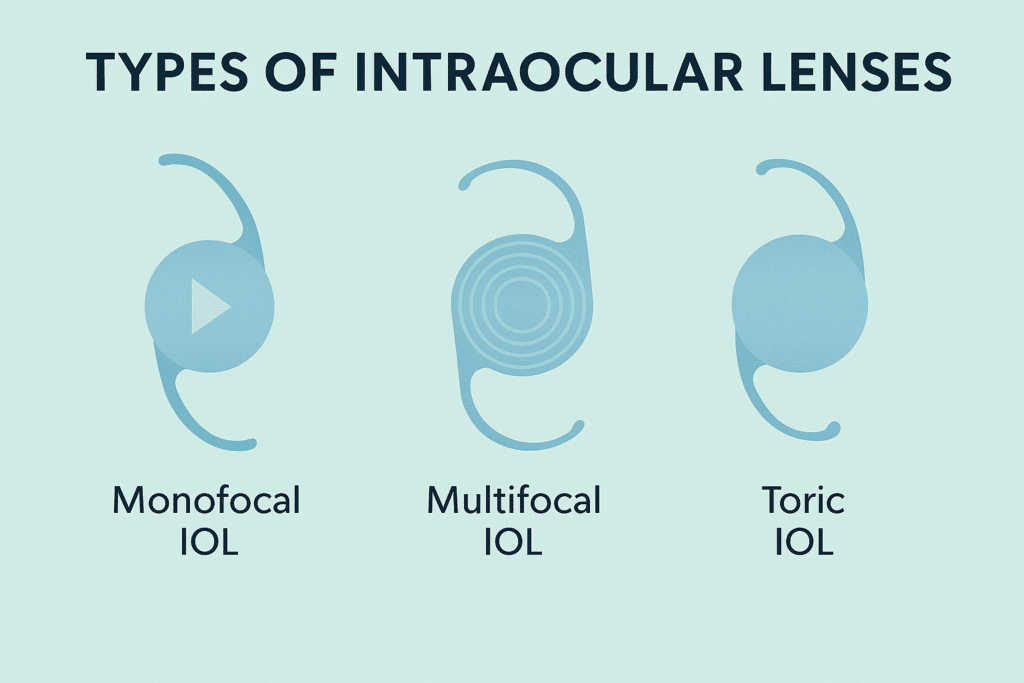Modern technology has advanced lens replacement surgery in London. Patients now have many choices beyond standard monofocal lenses. The newest cataract surgery lenses include state-of-the-art options from improved depth-of-focus lenses to light-adjustable implants that doctors can adjust after surgery.
Today’s premium lens selection includes multifocal, trifocal, toric, and light-adjustable technologies. Each type brings its own advantages. The PanOptics Pro trifocal lens demonstrates excellent results with 94% light utilisation compared to earlier versions. AI-based systems have also changed London’s lens replacement landscape. These systems create detailed digital maps of your eye’s curves and irregularities. This technology helps customise each procedure since every patient’s eyes are unique.
Your lens choice impacts both vision clarity and daily activities. Precision Vision London’s latest lens technologies deliver better visual results, clearer focus, and less dependence on glasses. We match options to your lifestyle and specific requirements to provide vision correction that fits your daily routine.

Understanding Lens Replacement Surgery in London
Lens replacement surgery ranks among the most popular elective procedures worldwide. This permanent solution helps people with various vision problems. The procedure replaces your eye’s natural lens with an artificial intraocular lens (IOL) that matches your specific visual needs.
What is lens replacement surgery and how it works
Refractive lens exchange (RLE), which people know as lens replacement surgery, gives you a premium artificial lens implant instead of your eye’s natural crystalline lens. This advanced procedure helps fix common vision problems like presbyopia (age-related difficulty with near objects), myopia (short-sightedness), hyperopia (long-sightedness), and astigmatism (blurred vision from irregular corneal shape).
Your surgeon needs just 15-30 minutes per eye to complete this day case procedure. They make a tiny cut in your eye, soften the natural lens with ultrasound, take it out, and put in your custom-designed artificial lens. The success rate is impressive – 98% of procedures have no complications, and most patients see better within 48 hours.
Here at Precision Vision London, we use advanced diagnostics to make sure your lens replacement matches your eye’s unique structure perfectly. The procedure looks like in modern cataract surgery but happens before cataracts develop.
Differences between cataract surgery and refractive lens exchange
While these procedures are similar in technique, cataract surgery and refractive lens exchange serve different purposes:
Cataract Surgery:
- Takes out a cloudy natural lens (cataract) to bring back clear vision
- Works best for patients over 60
- Doctors do it when medically needed
- Fixes vision loss from cataracts
Refractive Lens Exchange:
- Switches out a healthy natural lens to fix vision
- Works best for patients between 40-60
- People choose it to improve their vision
- Prevents future cataracts
The surgical technique stays the same, but RLE helps reduce dependence on glasses or contacts, while cataract surgery fixes cloudy vision. Both options use intraocular lenses that can improve vision at different distances.
Why more patients are choosing lens replacement over laser correction
Lens replacement surgery has become more popular than laser eye surgery like LASIK because:
- Age-appropriate solution: It fixes presbyopia – that annoying age-related lens hardening that makes reading tough after 40.
- Higher prescription suitability: You can get lens replacement even if your prescription is too high for laser correction.
- Elimination of future cataracts: Your new artificial lens means you won’t get cataracts later in life.
- Impressive success rates: About 95% of patients can see well enough to drive after the procedure.
- Permanent solution: Your artificial intraocular lens lasts a lifetime with almost no chance of vision changes over time.
People over 40 with presbyopia find reading glasses and varifocal lenses frustrating. Reading glasses need constant switching between tasks. Varifocal glasses make simple things like walking downstairs tricky because of the reading section at the bottom. Our patients at Precision Vision London love how advanced lens replacement fixes multiple vision problems at once. Most see dramatic improvements in their eyesight and enjoy life without glasses or contact lenses getting in the way.
Types of Intraocular Lenses (IOLs) Available Today
The rise of intraocular lens (IOL) technology has created remarkable options for patients who need vision correction through lens replacement. Modern lens replacement surgery has grown with innovative technology that will give a faster recovery, greater accuracy, and life-long clarity. Each premium lens type gives unique benefits that match different visual needs.

Monofocal lenses for single-distance clarity
Monofocal IOLs are the most common choice in lens replacement. They give excellent clarity at one specific distance, usually set for far vision. These lenses deliver outstanding visual quality at their designated focus point and work great for activities like driving or watching television. Notwithstanding that, you’ll probably need reading glasses for close-up tasks. The NHS provides monofocal lenses as their standard option for cataract surgery. You might want to think about a monovision approach to balance near and far vision. This means one eye gets a lens for distance and the other for near vision.
Multifocal and trifocal lenses for full-range vision
Multifocal and trifocal lenses are great options if you want to reduce your dependence on glasses. These IOLs have several focal zones that let your eyes switch focus between different distances. Trifocal lenses add an intermediate focal point that boosts your vision at computer-screen distance. London clinic patients can easily switch from reading to driving without changing glasses with these premium options. Research shows approximately 85% of patients with trifocal lenses don’t need glasses for daily activities. But some people might see halos around lights, especially at night.
Toric lenses for astigmatism correction
Toric IOLs provide custom correction for patients with astigmatism—a condition where the cornea’s curvature is irregular. These specialised lenses are the most reliable way to address corneal astigmatism as low as 0.75 dioptres. You can get toric lenses in monofocal, multifocal, and extended depth of focus versions. They help focus light properly on your retina for sharper vision. Proper lens positioning is vital since even slight misalignment can affect how well you see.
Extended Depth of Focus (EDOF) lenses for smoother transitions
EDOF lenses stand out as a state-of-the-art middle ground in premium lens options. These advanced lenses create one elongated focal point instead of distinct focal points. This gives you a continuous range of vision from distance to intermediate. The design leads to fewer visual disturbances than traditional multifocal lenses and offers better contrast sensitivity. EDOF technology works exceptionally well for computer-distance tasks. You might need reading glasses for very small print.

Light-adjustable lenses and how they work post-surgery
Light-adjustable lenses (LALs) are among the newest advances in London’s advanced lens replacement options. This innovative technology lets your ophthalmologist adjust your prescription after surgery with low-intensity ultraviolet light treatments. The adjustment starts about two weeks after surgery, and each treatment takes just minutes. Research shows that LALs help twice as many patients achieve 20/20 vision or better compared to standard IOLs. You’ll need to wear UV-protective glasses during the adjustment period until your final prescription is set.
Newest IOL Technology in the UK: 2025–2026 Innovations
The UK clinics now offer revolutionary premium intraocular lens designs that weren’t available a few years ago. These newest IOL technologies focus on natural vision with fewer visual disturbances and better performance in all lighting conditions.
TECNIS Odyssey: Full-range vision with low-light clarity
Johnson & Johnson’s TECNIS Odyssey marks a breakthrough in full visual range IOLs. The lens’s unique freeform diffractive surface design provides uninterrupted vision at every distance. Patients can see twice as well in low light compared to PanOptix and read 14% smaller print on average. Clinical data reveals that 93% of patients report no or mild halos, glare, or starbursts a month after surgery. The results speak for themselves—94% of patients are happy with their overall vision without glasses, and 96% can easily read smartphones and tablets.
PanOptix Pro: Enhanced trifocal optics with reduced glare
Alcon’s Clareon PanOptix Pro takes a leap forward with its ENLIGHTEN NXT Optical Technology. The lens achieves 94% light utilisation, up from its predecessor’s 88%. Light scatter drops by 50%, which means fewer halos and less glare. The lens creates 16% better contrast between distance and intermediate vision for sharper eyesight. These improvements lead to minimal visual disturbances—only 2.6% of patients say they’re “very bothered” by starbursts.
Envista Envy: Consistent clarity across lighting conditions
Bausch + Lomb’s Envista Envy shines in various lighting conditions through its ActivSync Optic intelligent energy distribution. This full-range IOL adjusts light distribution based on conditions, spreading light evenly in bright environments while prioritising distance vision in low light. Clinical trials show the Envista Envy outperforms monofocal lenses in monocular DCIVA and DCNVA. The lens maintains consistent visual acuity of ~0.1 logMAR from -1.50 to -2.50 D.
RayOne Galaxy: AI-designed ringless optics for reduced halos
Rayner’s RayOne Galaxy stands out as the world’s first spiral IOL, created with proprietary AI technology. Its non-diffractive spiral optic uses continuous and progressive power variance along spiral tracks to focus light at every position. This design delivers smooth vision from distance to near. Our surgeons at Precision Vision London use the latest AI-guided systems, premium IOLs, and laser precision techniques. The Galaxy IOL sends 100% of available light to the retina, keeping everyday vision naturally bright.
Zeiss Atlara: Smooth microphase EDOF design
Zeiss AT LARA Extended Depth of Focus IOL uses patented Smooth Microphase (SMP) technology to cut down light scattering and side effects. The surface design has shallower angles that boost manufacturing precision and reduce light scatter. Studies show 86% of patients report no or mild side effects. The continuous focus range provides visual acuity better than 0.1 logMAR up to about 55 cm.
Bausch + Lomb LuxSmart: Non-diffractive optics for digital lifestyles
The LuxSmart EDOF IOL uses Pure Refractive Optics Technology without diffractive rings. Its design combines opposite fourth and sixth-order spherical aberration in the central 2 mm to increase subjective depth of field to about 1.5 D. The lens excels at intermediate vision for computer use while maintaining clear distance vision. More than 90% of patients don’t need glasses for distance and intermediate vision.
Who is a Good Candidate for Advanced Lens Replacement?
Your candidacy for advanced lens replacement depends on your age, eye health, and vision correction needs. Let’s look at who can benefit most from this life-changing procedure.
Ideal age and eye health conditions
Lens replacement surgery works best for people aged 40 and above. Patients in their 50s or older make the best candidates. This age requirement exists because presbyopia starts affecting vision around this time. Your eyes need to be healthy and free from conditions like advanced glaucoma, diabetic retinopathy, or macular degeneration. A full picture at Precision Vision London will show your suitability by checking your corneal health, retina condition, and overall eye function.
Suitability for patients with presbyopia or high prescriptions
Lens replacement surgery stands out in correcting presbyopia—the age-related difficulty with near vision that affects almost everyone over 40. The procedure works exceptionally well for correcting high prescriptions that laser eye surgery can’t safely treat. Almost any level of myopia (short-sightedness), hyperopia (long-sightedness), or astigmatism can be fixed through advanced lens replacement.
Considerations for those with previous laser eye surgery
Previous laser eye surgery doesn’t rule you out from getting lens replacement. Specialists suggest waiting at least 6-12 months after laser surgery before you think over lens replacement. Laser surgery changes your cornea while lens replacement fixes your internal lens, so both procedures can work together at different life stages.
How Precision Vision London tailors lens selection to lifestyle
Precision Vision London’s lens selection process starts with understanding your visual requirements and what you just need from your vision. The clinic’s independent status lets them choose the most suitable lenses for your specific needs without manufacturer restrictions. Their detailed consultations help review your daily activities, work environment, and vision priorities to recommend the best lens technology.
What to Expect Before, During, and After Surgery
Getting ready for lens replacement surgery means understanding every step of your experience toward better vision. Precision Vision London helps you achieve exceptional results through careful preparation and personalised aftercare.
Pre-surgical diagnostics and eye mapping
Your experience starts with comprehensive eye tests that measure your eye’s dimensions and check for health conditions. These tests include visual acuity checks, eye pressure measurements, and advanced diagnostics to determine the ideal intraocular lens power. Your pupils will be dilated with eye drops that make your vision blur temporarily, so you’ll need someone to take you home.
Surgical process: from anaesthesia to lens insertion
The surgery day begins with anaesthetic eye drops that numb your eye. You can also opt for sub-Tenon blocks (“eye blocks”) which provide complete numbing for better comfort. Each eye takes about 15-30 minutes to complete. Your surgeon makes a tiny self-sealing incision, removes the natural lens using ultrasound technology (phacoemulsification), and positions your chosen IOL carefully.
Post-operative care and follow-up at Precision Vision London
You’ll rest briefly in our recovery room after surgery before our specialist nurse examines you. Most patients notice improved distance vision within 24-48 hours. Book your consultation today and experience London’s most advanced approach to vision correction.
Common side effects and how they are managed
You might notice temporary light scatter effects (glare/halos), blurred vision, mild discomfort, or red blotches. These symptoms usually get better within months. Simple solutions like lubricating eye drops and non-prescription sunglasses help manage discomfort and light sensitivity.
Recovery timeline and visual adaptation period
Light activities can resume within days, and you can drive once your vision meets legal requirements. Full visual recovery takes about 4-6 weeks, with complete healing occurring within eight weeks. If you have multifocal lenses, your brain might need 3-6 months to adjust fully to the new visual experience.
Conclusion
Lens replacement technology has changed what’s possible in vision correction beyond what doctors imagined a few years ago. This article shows how modern surgical breakthroughs give remarkable results to patients who want freedom from glasses and contact lenses. Premium lens options now available – from improved trifocal designs like PanOptix Pro to revolutionary light-adjustable implants – will give you a customised solution that matches your visual needs.
Without doubt, advanced diagnostic technology drives the precision of today’s lens replacement procedures. AI-guided systems at Precision Vision London create detailed digital maps of your eye’s structure that allow completely customised treatment. Your surgery addresses not just general vision correction but your specific lifestyle needs.
The surgical process has become more efficient and comfortable. Most patients see major vision improvements within 48 hours. Full adaptation happens over several weeks as your brain adjusts to the new visual experience. Your age, eye health, and visual goals play vital roles in determining the ideal approach to lens replacement surgery. Precision Vision London excels at matching these factors with the right lens technology that ensures optimal results for you.
Lens replacement surgery is an investment in lifelong visual freedom. Side effects might occur during recovery but resolve quickly under expert guidance. The long-term benefits make this procedure popular among adults over 40 – you’ll eliminate future cataract concerns while gaining exceptional vision at multiple distances. This procedure stands out as one of the most transformative vision correction options today. With careful pre-surgical planning, advanced lens technology, and detailed aftercare at Precision Vision London, you can expect outstanding results that improve your quality of life for years ahead.
FAQs
Q1. How long does it typically take to fully recover from advanced lens replacement surgery? Most patients experience significant vision improvement within 48 hours, but full visual recovery usually takes 4-6 weeks. Complete healing occurs within about eight weeks. For multifocal lenses, neural adaptation may continue for 3-6 months as your brain adjusts to the new visual experience.
Q2. Who might not be suitable for advanced lens replacement surgery? Individuals under 40, those with certain eye health conditions like advanced glaucoma or macular degeneration, and people with unstable eye prescriptions may not be ideal candidates. A thorough eye examination is necessary to determine suitability.
Q3. What restrictions should I expect after undergoing lens replacement surgery? For the first few days, you should rest and avoid strenuous activities. Most patients can return to light activities within days but should avoid heavy lifting, swimming, and dusty environments for a few weeks. You can usually drive once your vision meets legal standards.
Q4. What are some potential side effects of advanced lens replacement surgery? Temporary side effects may include light scatter effects (glare/halos), blurred vision, mild discomfort, or red blotches. These typically improve within months. Lubricating eye drops and non-prescription sunglasses can help manage discomfort and light sensitivity.
Q5. How does Precision Vision London tailor lens selection to individual lifestyles? The clinic conducts comprehensive consultations to evaluate your everyday activities, work environment, and vision priorities. They use this information, along with advanced diagnostic tests, to recommend the optimal lens technology that best suits your specific needs and lifestyle demands.
Authors & Reviewer
-
 Olivia: Author
Olivia: AuthorHi, I'm Olivia, a passionate writer specialising in eye care, vision health, and the latest advancements in optometry. I strive to craft informative and engaging articles that help readers make informed decisions about their eye health. With a keen eye for detail and a commitment to delivering accurate, research-backed content, I aim to educate and inspire through every piece I write.
-
 Dr. CT Pillai: Author
Dr. CT Pillai: AuthorDr. CT Pillai is a globally recognised ophthalmologist with over 30 years of experience, specialising in refractive surgery and general ophthalmology. Renowned for performing over 50,000 successful laser procedures.

